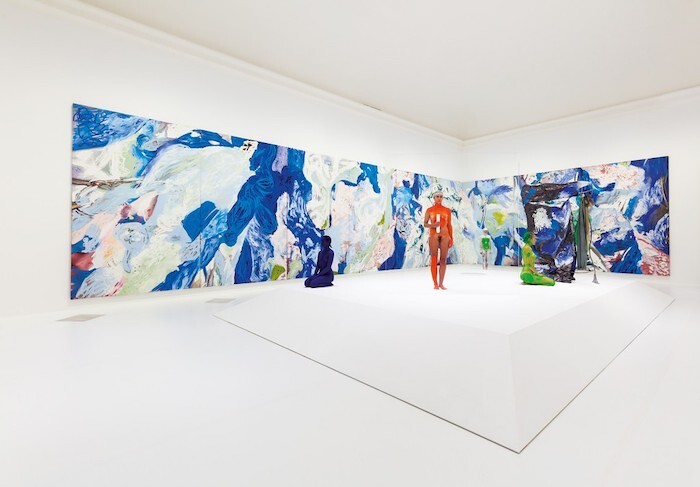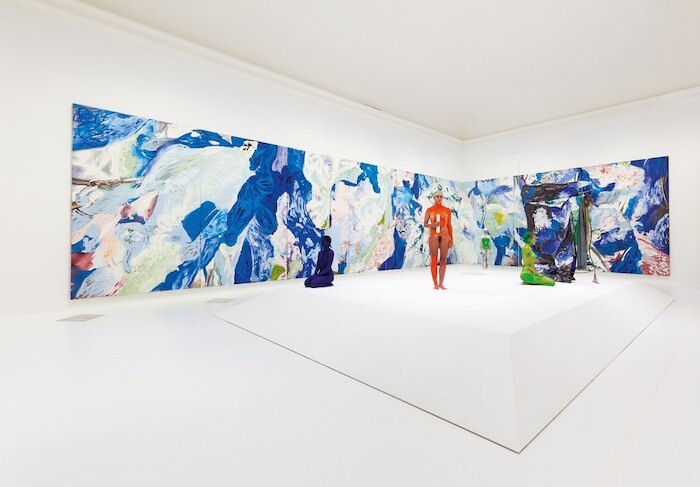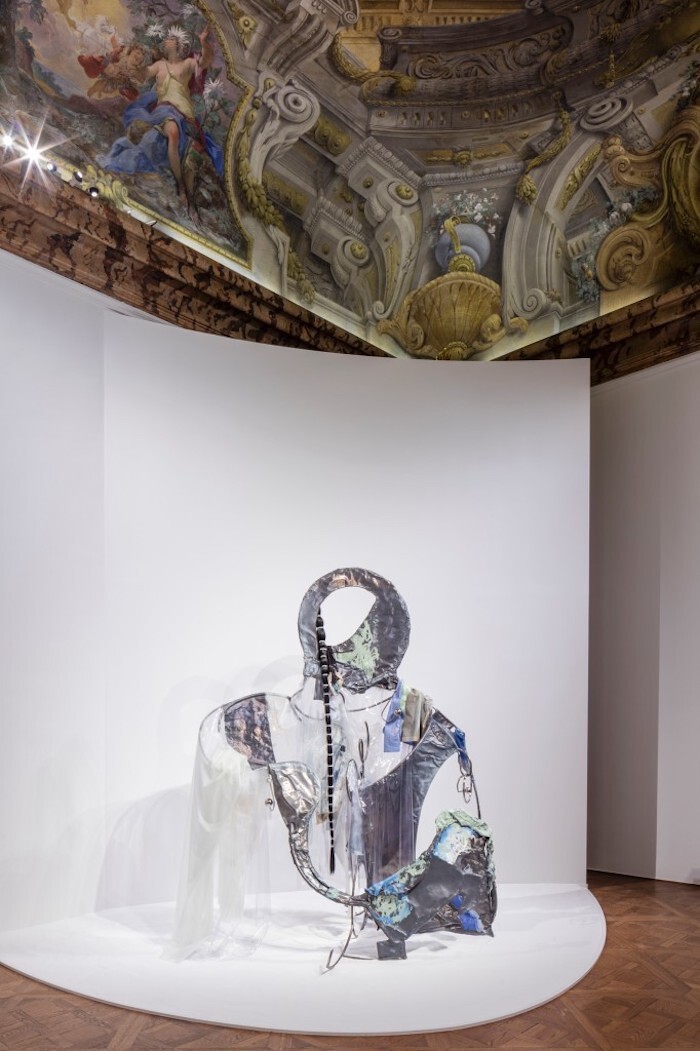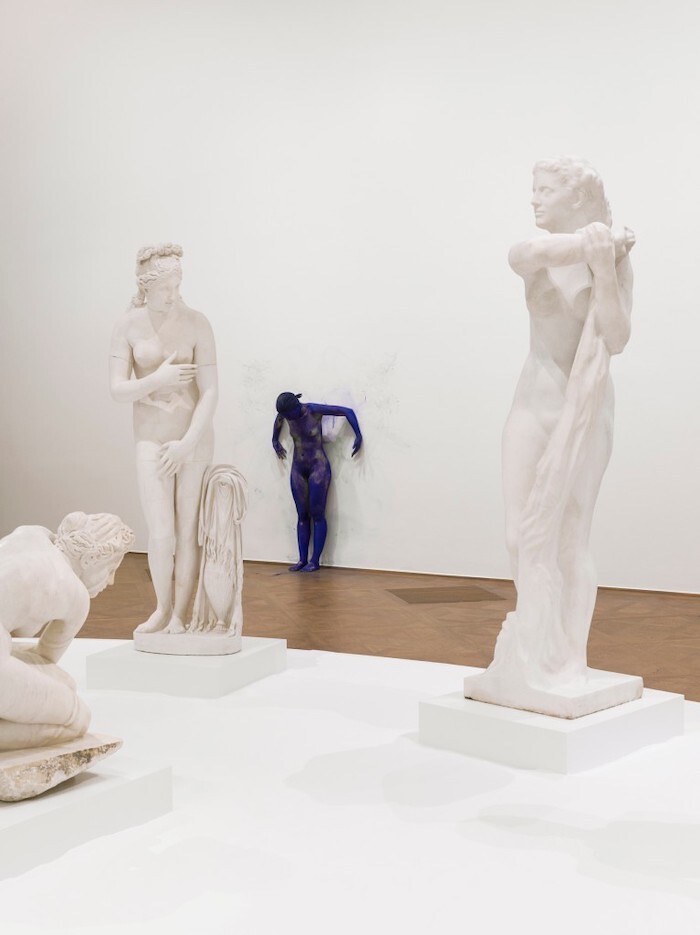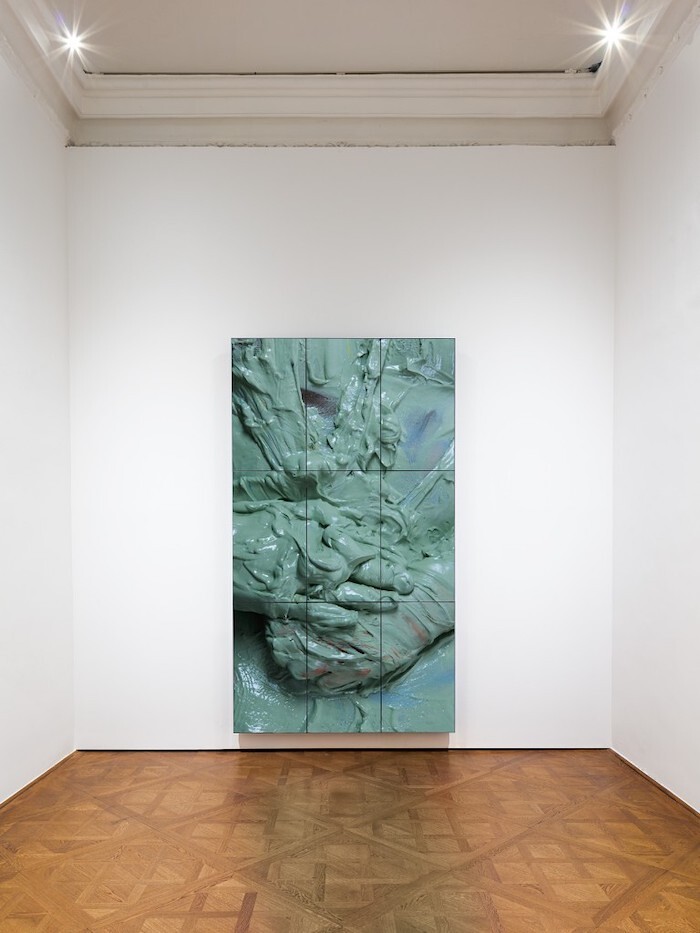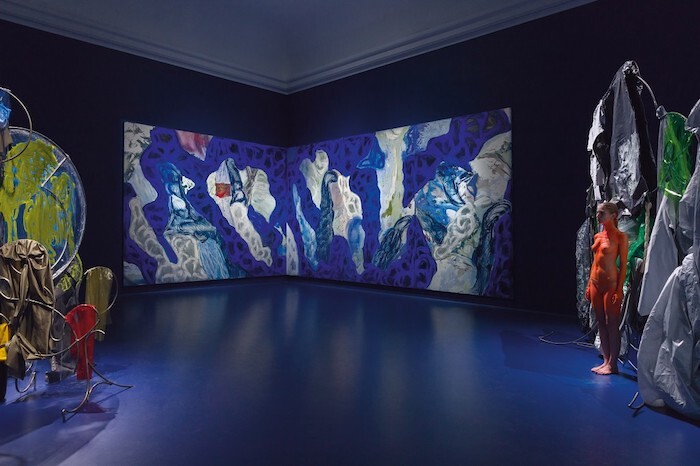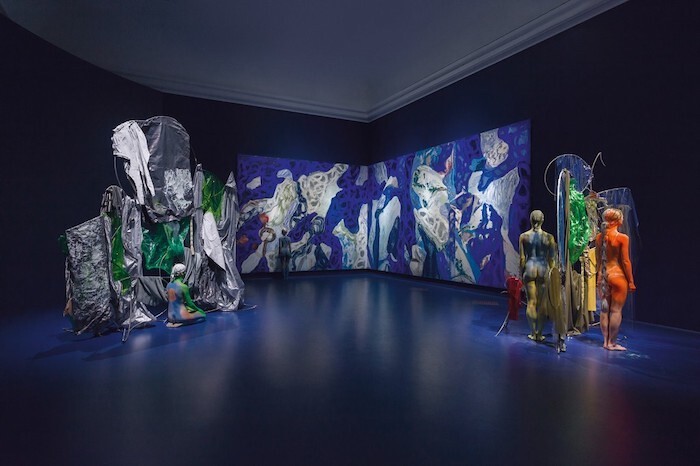Flatness, surface, posture, and the notion of cycles animate Donna Huanca’s “Piedra Quemada” [Scorched Stone]. The exhibition, displayed across Vienna’s Lower Belvedere museum, is a Gesamtkunstwerk consisting of 33 works including paintings, mixed-media sculptures, and live models whose bodies, painted by the artist with bright colors, move slowly throughout the space. In the first room, blue, green, white, and pink oil and acrylic paints billow across ten canvases. The paintings’ titles (all works 2018) point to forms of containment, growth, process, and sedimentation, as in MOULD, CYANOBACTERIA (bacteria which gain energy through photosynthesis), and ACRITARCH (an organic microfossil believed to be up to 1400 million years old).
In the center of the room is a platform covered in a layer of almost invisible white powder, which carries traces of foot and body prints made by Huanca’s models. Displayed on the platform is the steel frame of PARA ELYSIA (MARIPOSA) [For Elysia (butterfly)], one of the five mixed media sculptures presented in the show. Stretched and pulled around the skeletal structure whose shape evokes a head and torso are scrunched plastics painted with opalescent oils and acrylics. A rope made from synthetic black hair further anthropomorphizes the work. In the multi-screen video works ABUELITA VERDE [Green Granny] and SAPO SANGRE [Blood Frog], hands feel through gray sludge or sensuously push paint and fabric across skin, the body’s membrane treated as canvas.
Built during the early eighteenth century as the palace of Prince Eugene of Savoy (1663–1736), in 1903 the Lower Belvedere was adapted from a place of aristocratic and imperial absolutism to a space for secularized art exhibitions. The sound installation TECO Y ZENON (PARENTS SPEAKING) plays in the Baroque Marble Gallery. Its ceiling features a fresco of Apollo riding a sun chariot and sculptures of Providentia. Personifications of Vienna’s four main rivers fill the floor and statues of ankle-shackled prisoners adorn the walls. Intimate conversations between the artist’s parents, during which her father and mother discuss Quechua, echo around this space of pre-conditioned ritual.
“Piedra Quemada” has an undulating narrative form. Viewers are guided from room to room as if from light to darkness, from rationality to magic. The fourth room contains five classical statues of women, dating from 200 BCE to the twentieth century. Facing each other, their backs turned to the viewers, they form the hermetic world-within-a-world of “Piedra Quemada.” Their supports—which resemble the steel frames of Huanca’s sculptures—hold them in upright or crouching postures. These marble and plaster figures point to a heritage of figuration, proportion, and gesture. In contrast, the edges of the room carry impressions from Huanca’s live models. Like Yves Klein’s “Anthropometry” series (1960), Huanca’s models have pressed their bodies along the entirety of the wall, leaving faint colored imprints.
The final room, with its deep blue walls, draws viewers into another space of ritual. On each wall hang huge, swirling, Gustav Klimt-esque canvases—ten in total, mirroring the first room. Collectively titled “MAGMA,” these paintings in oil, acrylic, and blue pigment evoke a kind of atavistic, disfigured time against the frozen time of the classical statues. The smell of myrrh drifts across the room. Here, art is wrenched into the space of myth, yet this move is countered by the large mixed-media sculptures displayed in front of the paintings, which absorb the new through their materials. In this warm, scented room is a model, guarded by white-clad invigilators, sitting still. They are painted blue and white, divided in sharp lines down the middle of the torso; they move sideways, becoming almost invisible as their blue blends with that of the wall.
As if drawing equivalences between Klein, Viennese Actionism, and Ana Mendieta, Huanca’s painted humans are flattened and de-situated. The artist draws on the tradition of treating the human-as-artwork as an ideal form, which testifies to the institutionalization and integration of the “neo avant-garde.” In a recent conversation with Isabelle Graw, Huanca claimed that her models let go of expected norms and behaviors to “detach from their ego,” revealing a latent idealism.1 Yet in these billowing paintings, which reflect on posture and fashion, there is an impulse toward placation. In appealing to a mix of geological time, the cyclical, distracting time of fashion, and the dead-labor time expended by Huanca’s models, is this exhibition neutralized of its force in the present? It is unclear whether Huanca’s creation of a para-world in “Piedra Quemada,” within an old home whose echoes of absolutist rule are still visible, assaults a hostile, external world or merely decorates it.
Donna Huanca and Isabelle Graw, “Comfortable in Their Skin: A conversation between Donna Huanca and Isabelle Graw,” in DONNA HUANCA: PIEDRA QUEMADA (Vienna: Verlag für Moderne Kunst, 2018), 47.
